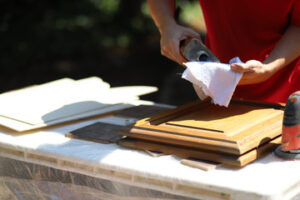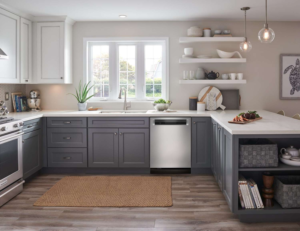Siding protects your home from the elements. It also influences energy efficiency and durability. When choosing a contractor, ask about their experience with different siding materials and what kind of warranties they offer. Contact Charleston Siding Pros now!
Natural wood siding is a classic look that offers a high level of durability when sealed, stained or painted at regular intervals. However, it can become susceptible to rot and rodent damage over time.

Siding significantly impacts a home’s appearance, creating first impressions that signal a well-maintained property. It also enhances the architectural style and contributes to a home’s value, making it one of the top remodeling investments homeowners can make.
Creative siding designs offer endless opportunities to boost curb appeal. Ideas range from using vibrant colors to experimenting with textures and materials. They can create unique exteriors that reflect individual styles and add character to the house.
Color plays a major role in a house’s aesthetics, as it can set a mood and convey a sense of history and tradition. Dark and rich hues can add a stately presence, while lighter shades can make a home appear larger and more inviting. Textured sidings, such as those mimicking natural wood grain or stone, add dimension and depth to a home, further elevating its visual appeal.
The color of a home’s trim and accent pieces is another important factor when it comes to enhancing curb appeal. A fresh coat of paint can dramatically improve a home’s appearance, but it is important to choose a shade that compliments the existing trim. A good way to find complementary colors is to use the color wheel and examine a few swatches on your home.
Planting beds are another easy and inexpensive way to boost your home’s curb appeal. When planning a new garden bed, choose plants that frame your house and complement the color of its siding. Adding a garden gate or short sections of decorative fence panels can add a stylish touch and help define a garden bed’s layout.
Other ways to improve a home’s curb appeal include changing mailboxes, front door hardware, and porch lighting. It is essential to choose finishes that are consistent with the overall look of your home, as mismatched pieces can make a house look unfinished and unkempt.
Increasing the curb appeal of your home is an excellent way to increase its value and attract potential buyers. It is important to remember that your siding is the first thing visitors and prospective homebuyers see, so it must look great! Choosing the right color and style of vinyl siding will ensure that your house has the best possible first impression.
Durability
When it comes to choosing the right siding for your home, durability is an important factor to consider. Siding that is durable will last longer, meaning you won’t have to worry about replacing it as frequently. There are many different types of siding available that provide durability, including wood, vinyl, and fiber cement. Each type of siding has its pros and cons when it comes to durability, so be sure to weigh all your options before making a decision.
One of the most popular types of siding is vinyl, which offers a high level of durability and requires minimal maintenance. It can withstand wind, hail, and other weather elements, and is resistant to fire, insects, and rot. However, it can crack or warp over time and is susceptible to damage from impact. In addition, vinyl can be prone to fading and is not as energy efficient as other siding materials.
Fiber cement is another option that provides a long lifespan and is highly durable. It is made of a combination of cement, cellulose fibers, and sand and can be manufactured to look like wood, stucco, or stone. It is also fire-resistant and insect-proof, which makes it a great choice for homeowners who want to add a bit of natural style to their home.
Stucco is another popular choice for its strength and aesthetics, especially since it can be easily painted to suit your style. It is also resistant to insect infestation and is strong against both fire and bad weather, but it can be susceptible to water damage if not properly maintained.
Lastly, brick is another excellent choice for its durability and classic appearance. It can withstand bad weather, wind, and insects, and it is also an eco-friendly material that helps conserve energy.
Lastly, natural wood is a great choice for its rustic appeal and beauty, but it can be more prone to durability issues than other siding materials. For example, it can rot and be damaged by moisture, and it must be stained or painted regularly to prevent this from happening. However, if it is cared for correctly, natural wood can last up to 40 years.
Cost
There are a number of factors that influence the cost of siding. These factors include the material, size of your home, and style of your home. For example, you’ll pay more to replace the siding on a two-story house than a single-story house. The reason is that the second story requires a lot more materials, labor and equipment to install. Also, the architecture of your house could increase costs as well. For example, a Tudor Revival-style house with steep roof pitches, large gables and half-timbering will increase the cost of the renovation because these features require more intricate craftsmanship.
In addition, the cost of the renovation can be affected by the time of year you choose to have the work done. For instance, the price of materials tends to be higher during spring and summer when demand is high. You can cut costs by choosing to have the work done during a less busy season, such as early fall.
Another factor that influences the cost of siding is its thickness. The thinner the siding, the more it will expand and contract in response to temperature changes. Thinner vinyl is typically more affordable but doesn’t provide as much insulation as thicker options.
The type of siding you choose will also affect the cost. Wood and fiber cement siding are more expensive than vinyl, but they offer a more authentic look. However, they’re more prone to moisture damage and may require more maintenance. Natural wood will also need to be repainted and resealed often, which can add up over time.
When you’re shopping for a contractor, be sure to get a bid that includes all costs associated with the renovation. For example, the cost of removing the existing siding and disposing of it will likely run around $2,000 for basic materials like fiber cement and aluminum. Painting stone, brick and stucco siding with specialized coatings can double that cost.
You may also need to spend money on a permit and inspections, depending on the location of your home. These expenses can be as low as $100 or as high as $5,000, so it’s important to check with local authorities to determine what you’ll need to pay for.
Installation
The siding on your home does a lot more than protect it from rain and snow. It also helps your house maintain its value, ensuring that it continues to look attractive even after years of exposure to the elements. But installing siding is a complex process that requires the help of a professional. Even the best quality siding can buckle or warp if it isn’t installed correctly. If you want to save money by doing it yourself, there are several things you should know before you start.
The first step in the installation process is preparing the wall to accept the new siding. Start by determining the lowest point of the wall you want to side and driving a nail there. Then snap a chalk line around the entire perimeter of your house to serve as a reference guide for the rest of the work. Next, nail a strip of plywood about 3 inches thick above the chalk line to hold out the bottom row of siding. Nail the starter strip to the plywood, but don’t nail it tightly.
Another important step is creating a water-resistive barrier to stop moisture from getting behind the siding. This is especially crucial in cold climates where frost can damage sheathing and wood framing. Installing this barrier will help keep your home warm and dry in the winter and help reduce humidity levels that can cause mold and mildew problems.
Once the waterproofing barrier is in place, you can begin to install the vinyl siding itself. If you’re a do-it-yourselfer, follow the instructions in the manufacturer’s manual and watch online how-to videos for guidance. Alternatively, you can hire a professional to do the job for you.

